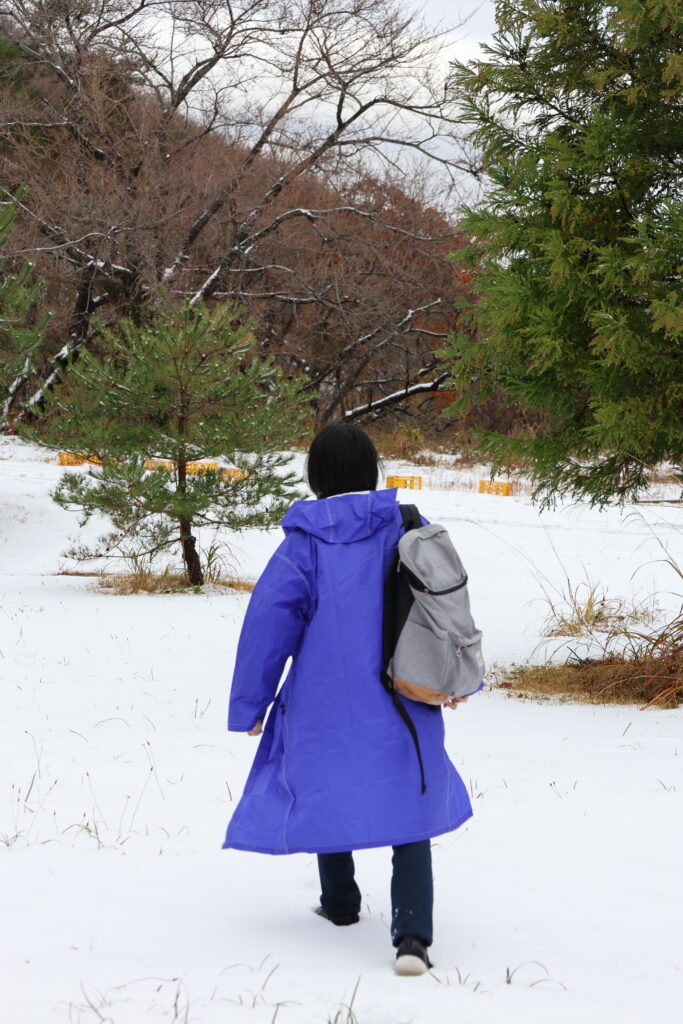
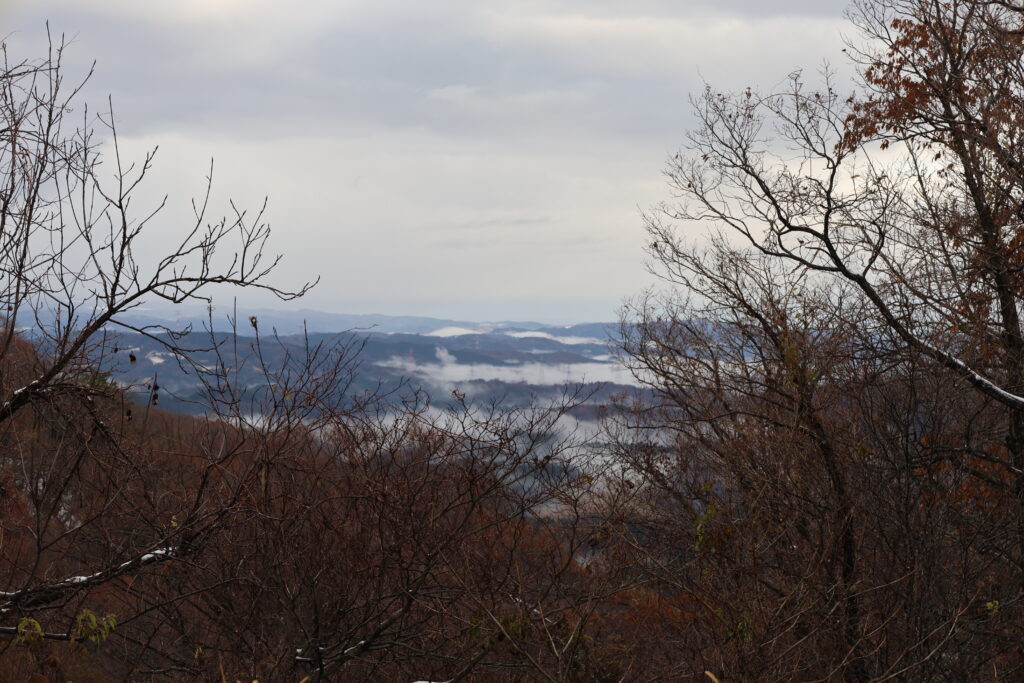
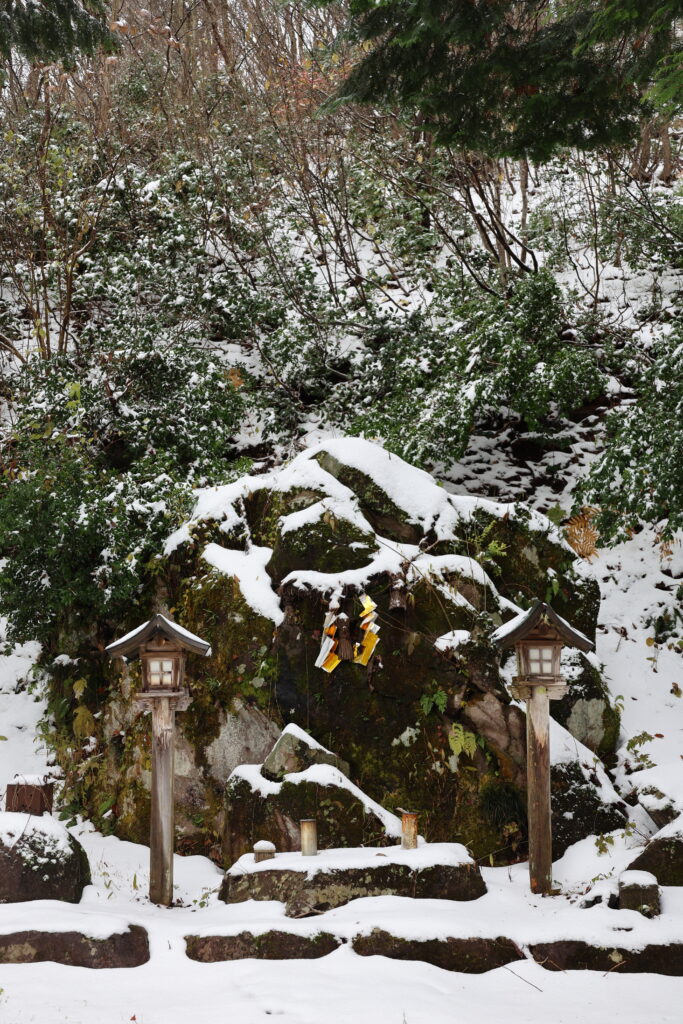
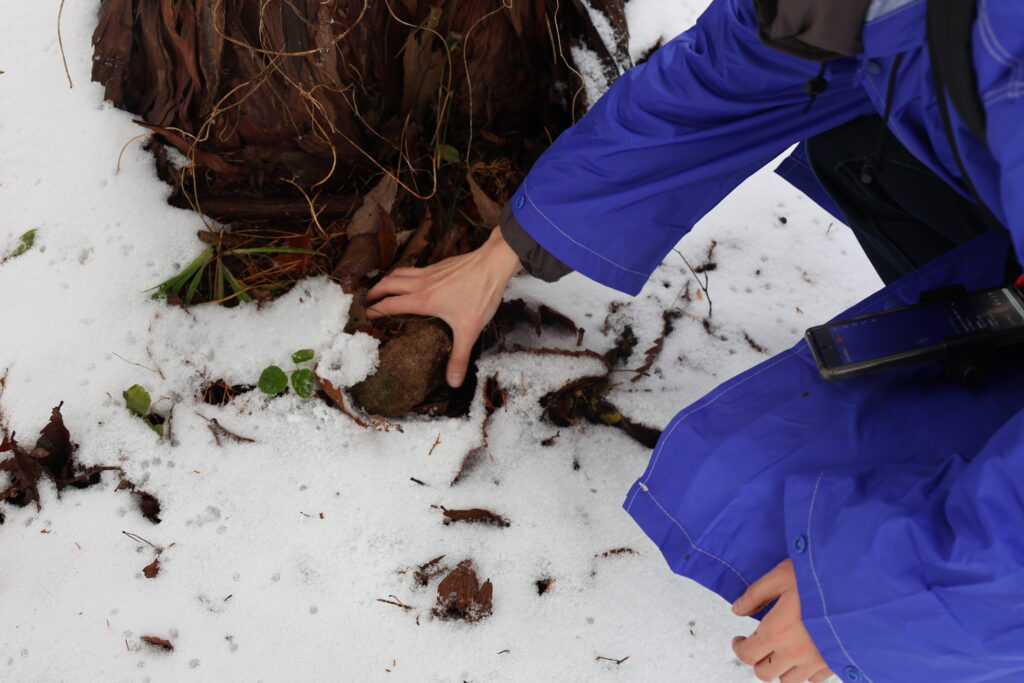
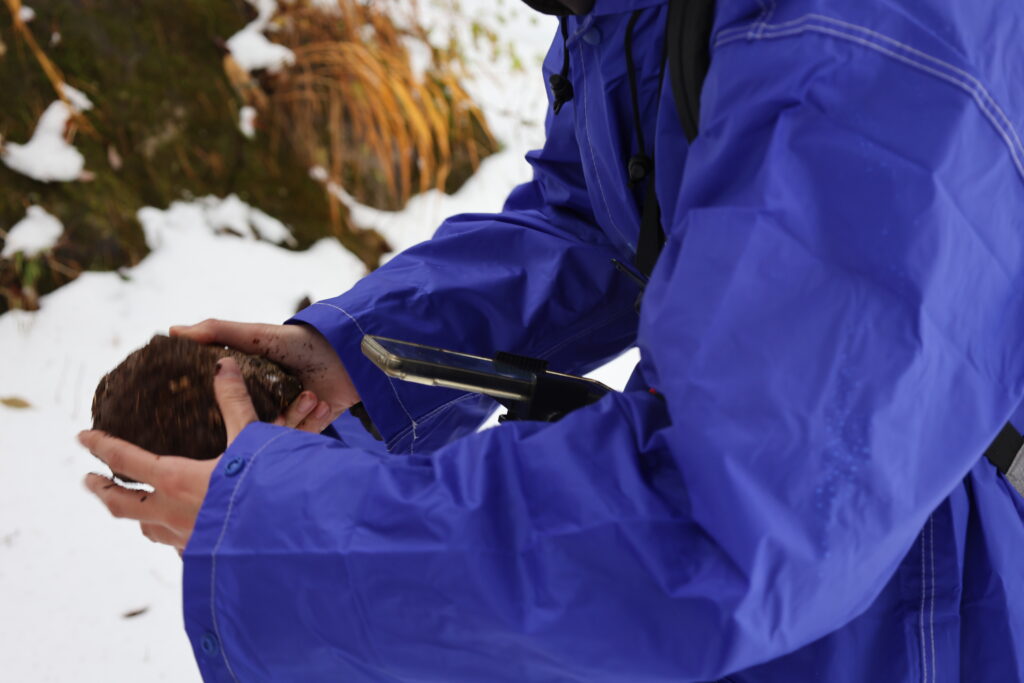
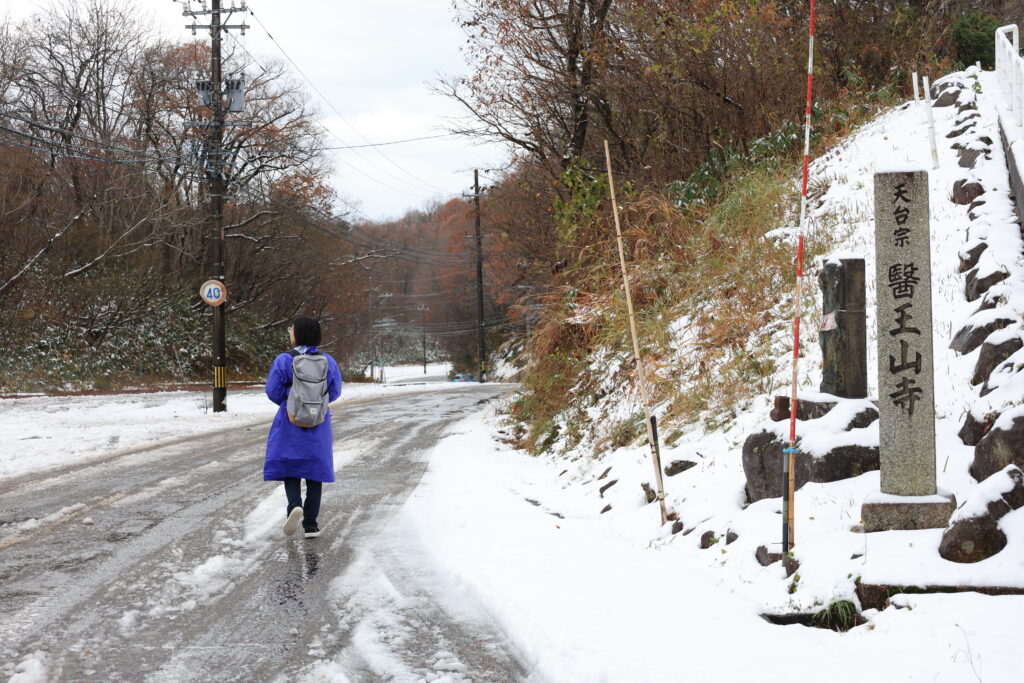
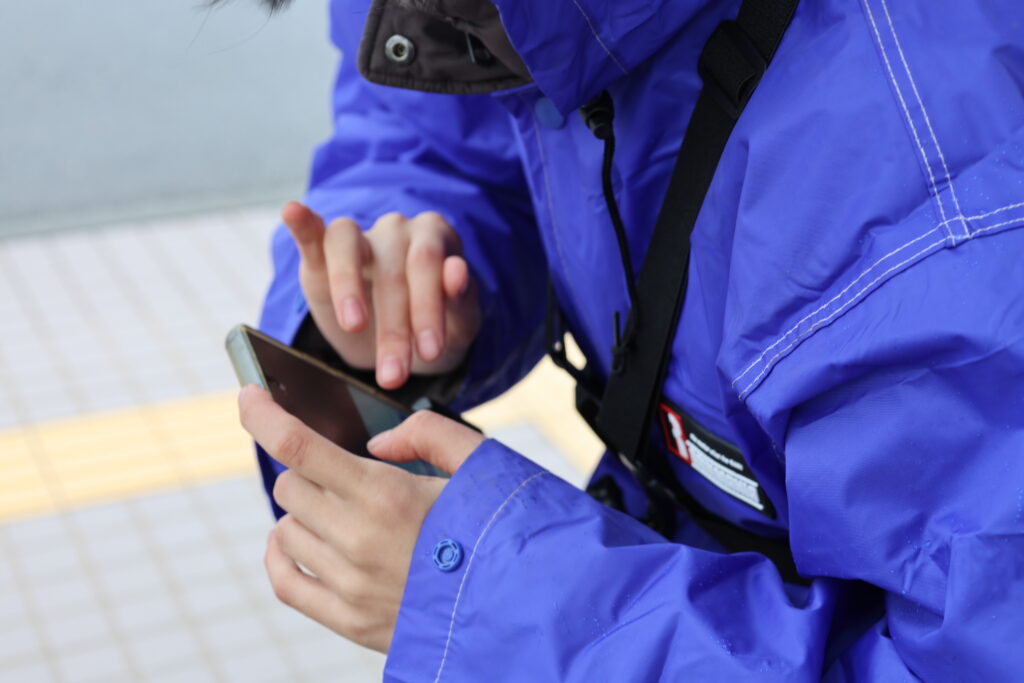
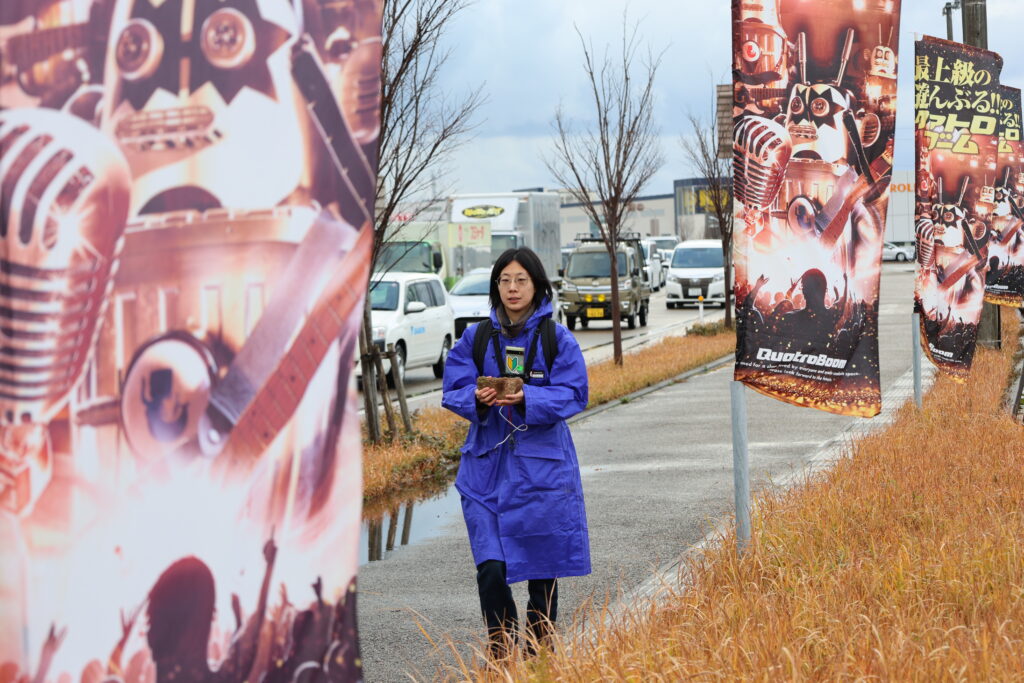
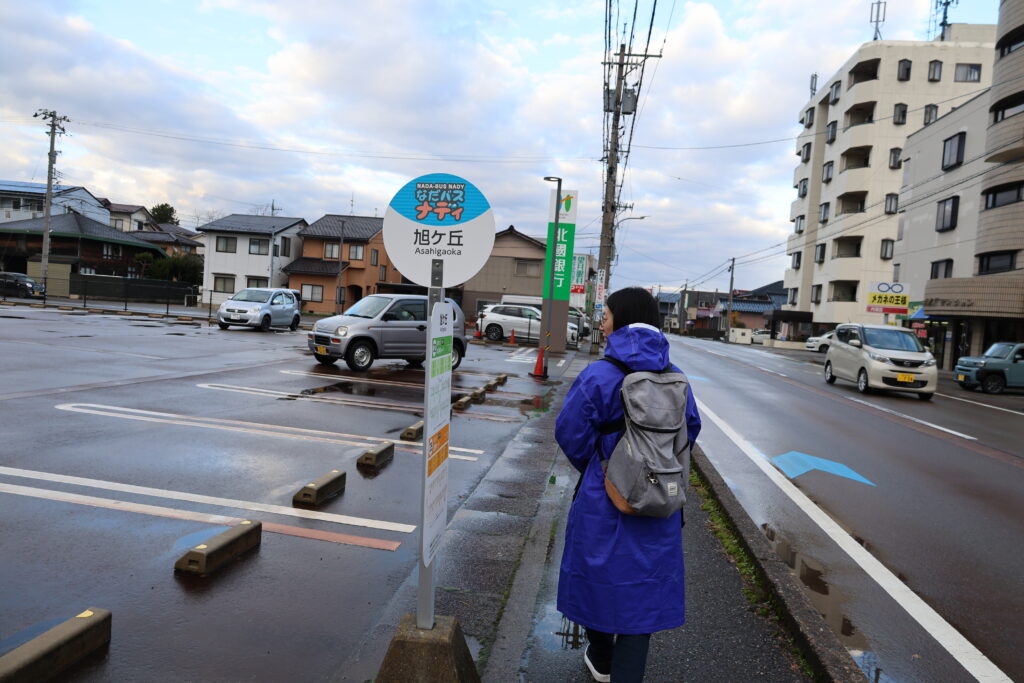
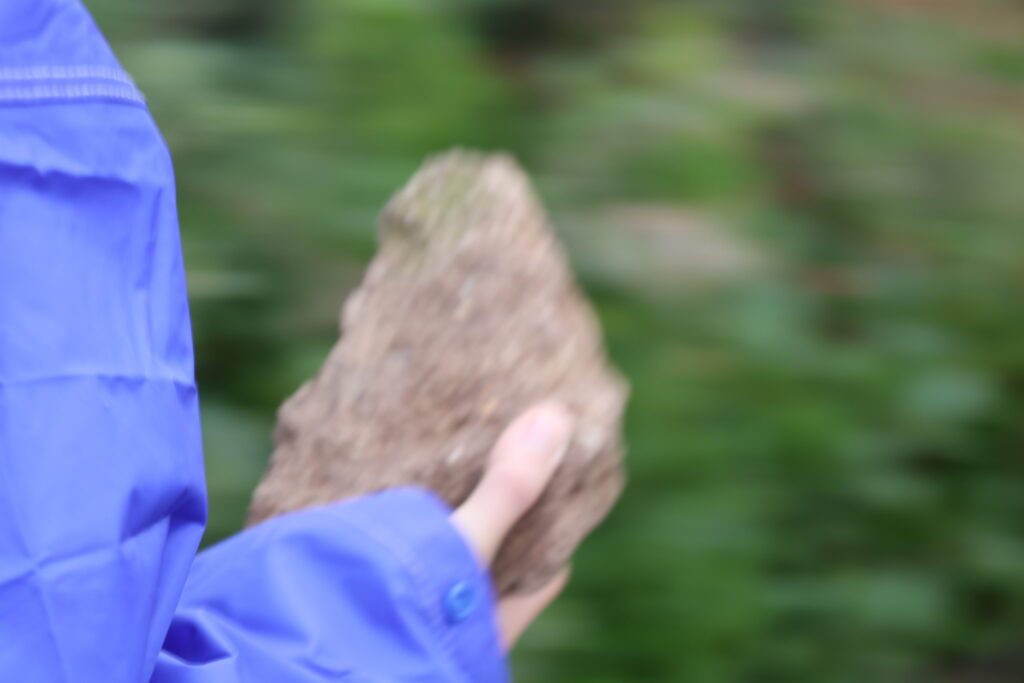
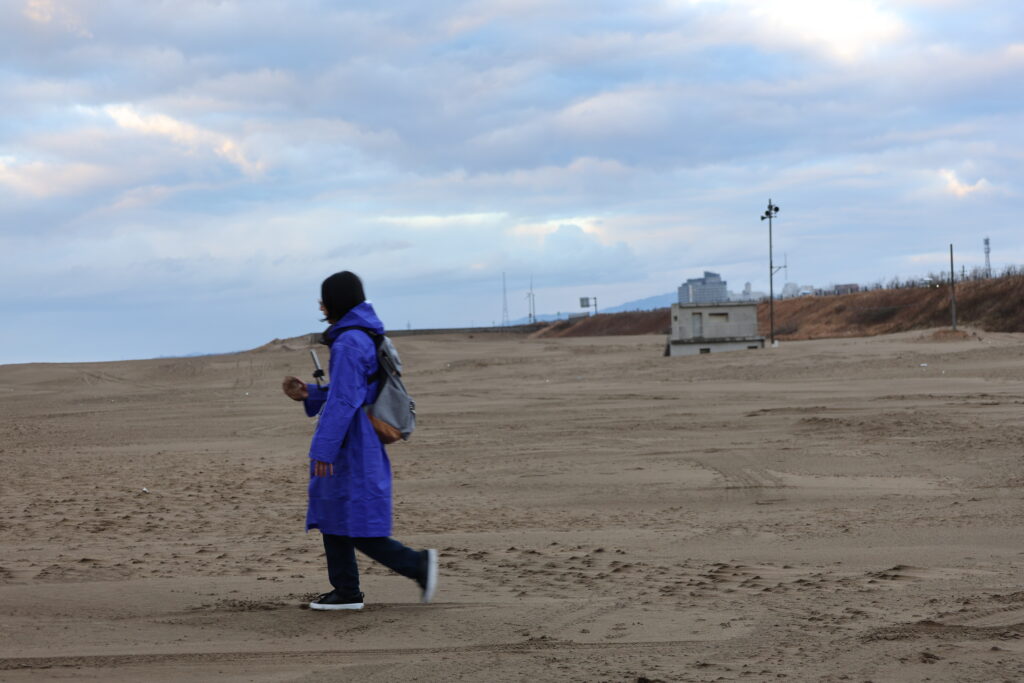
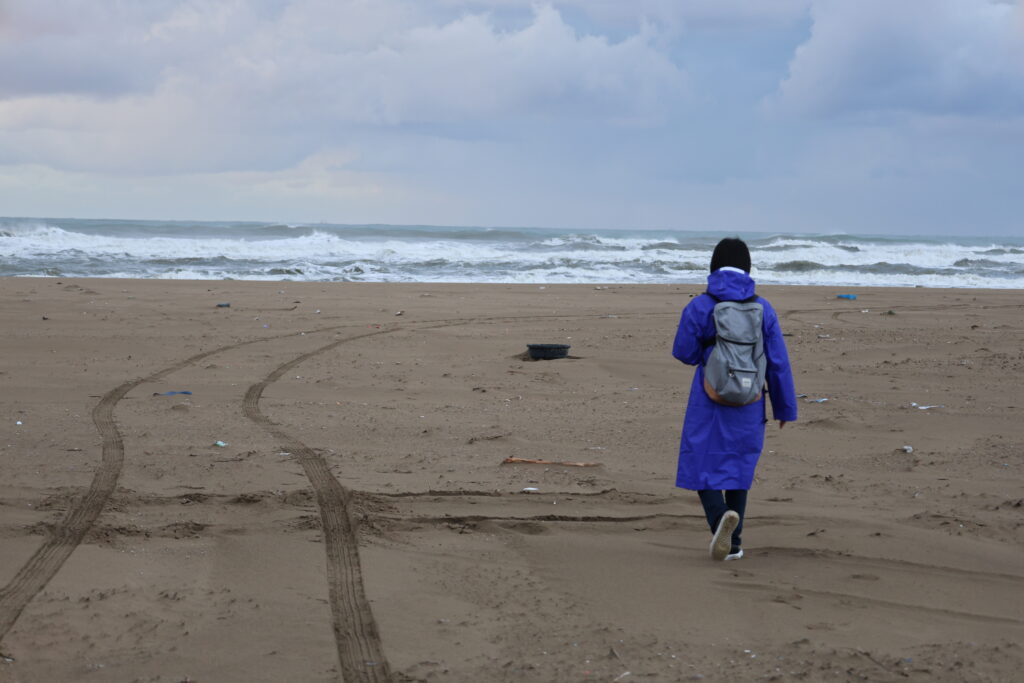
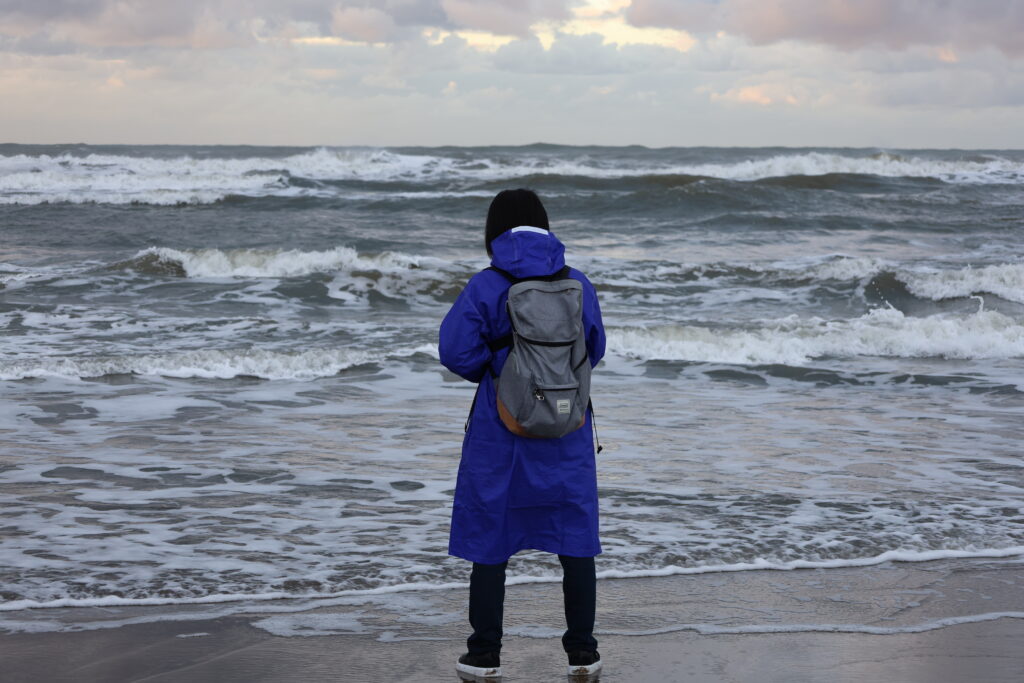
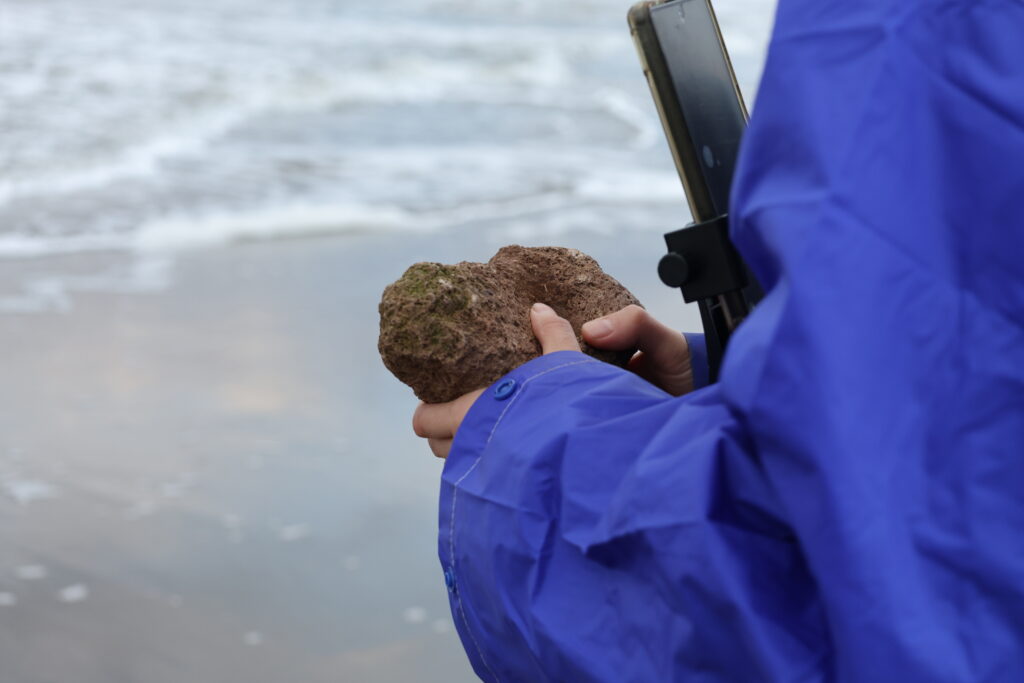
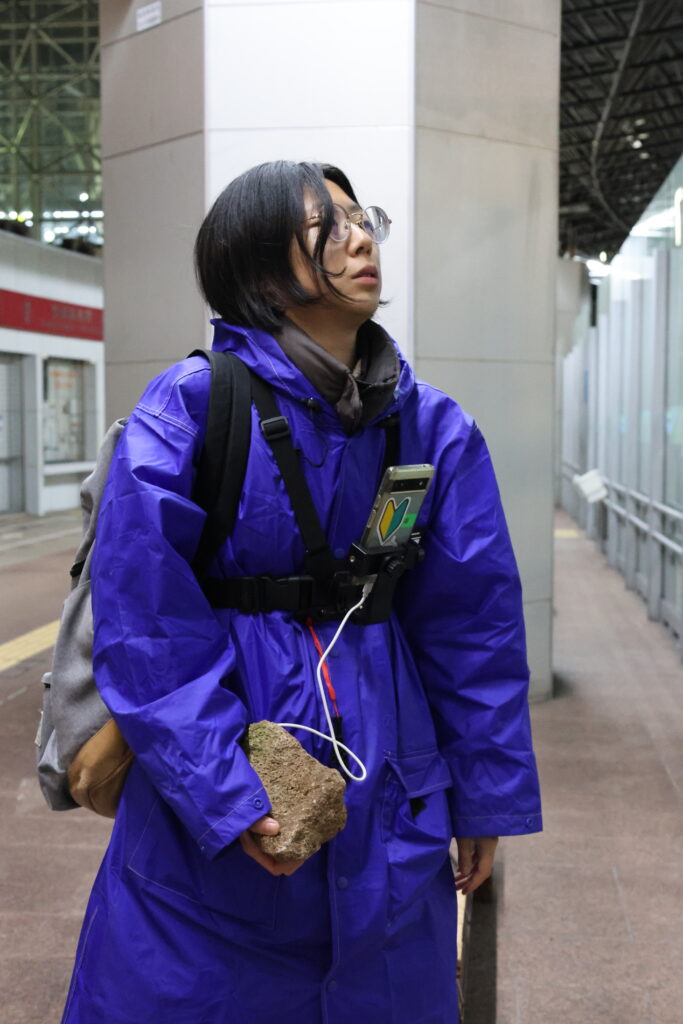
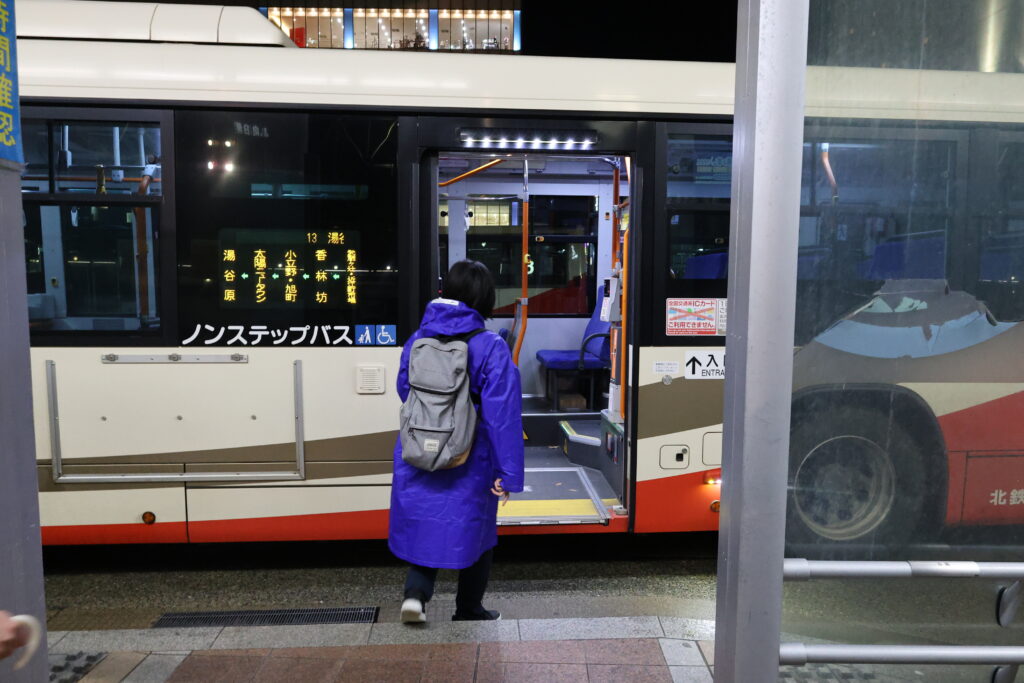
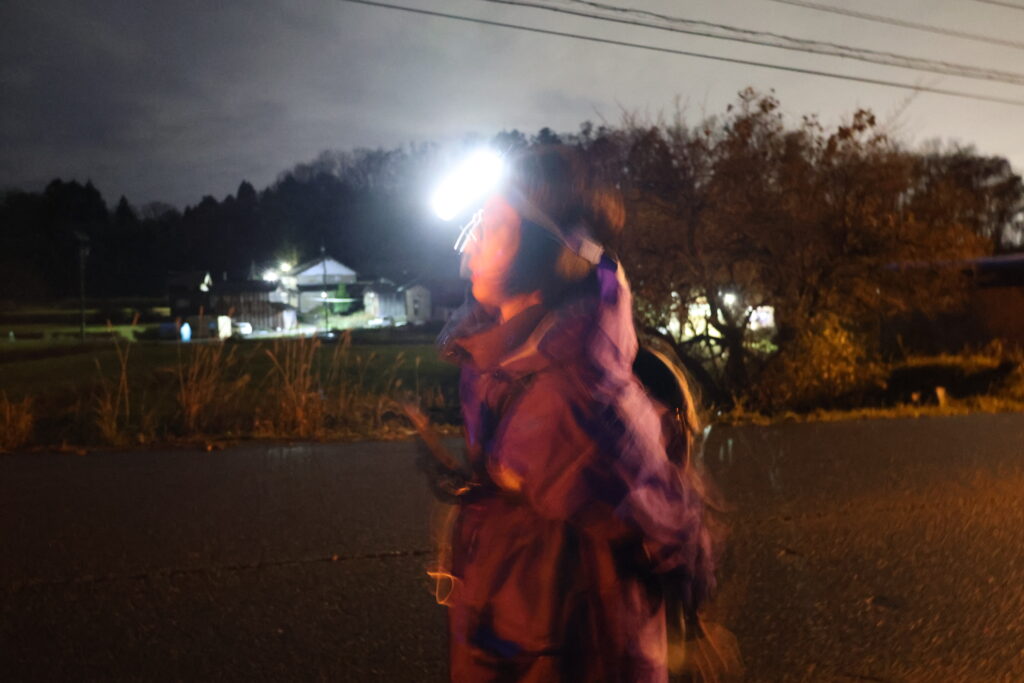
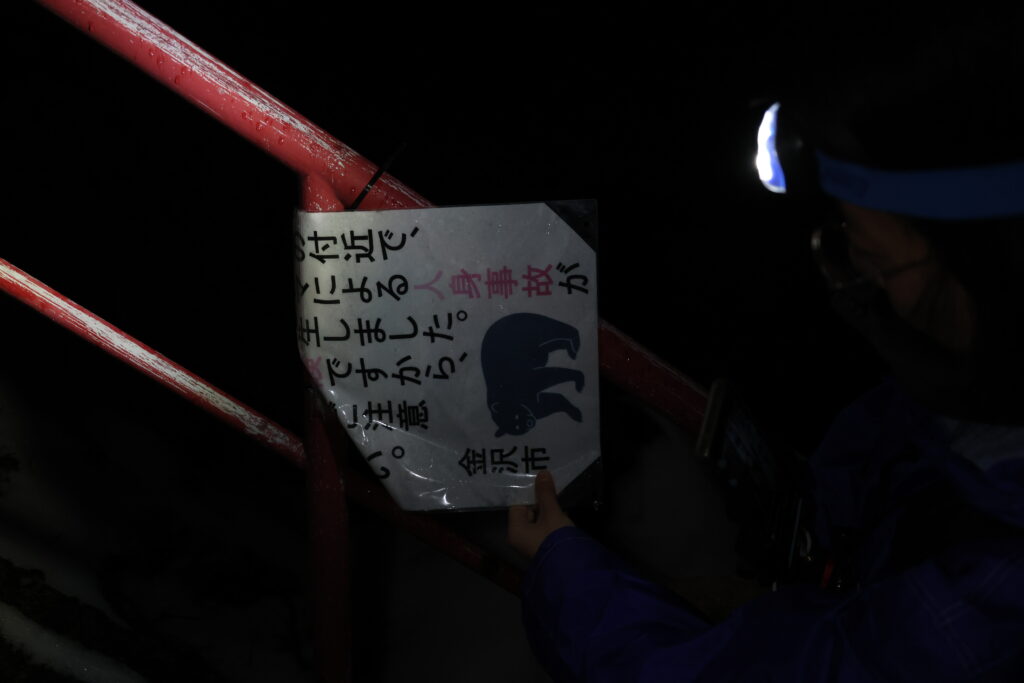
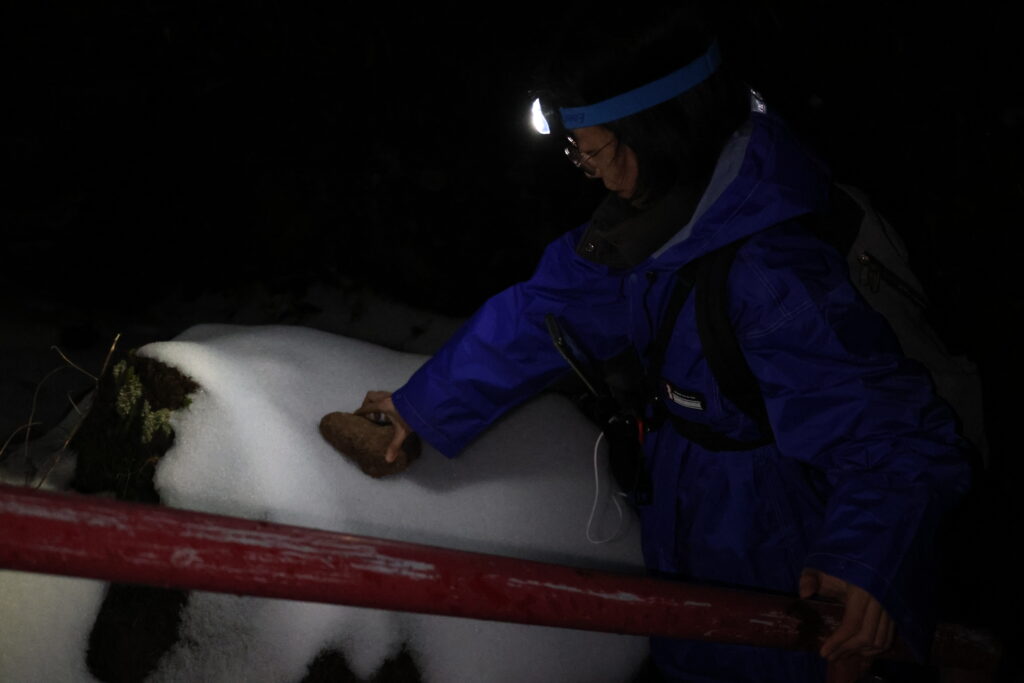
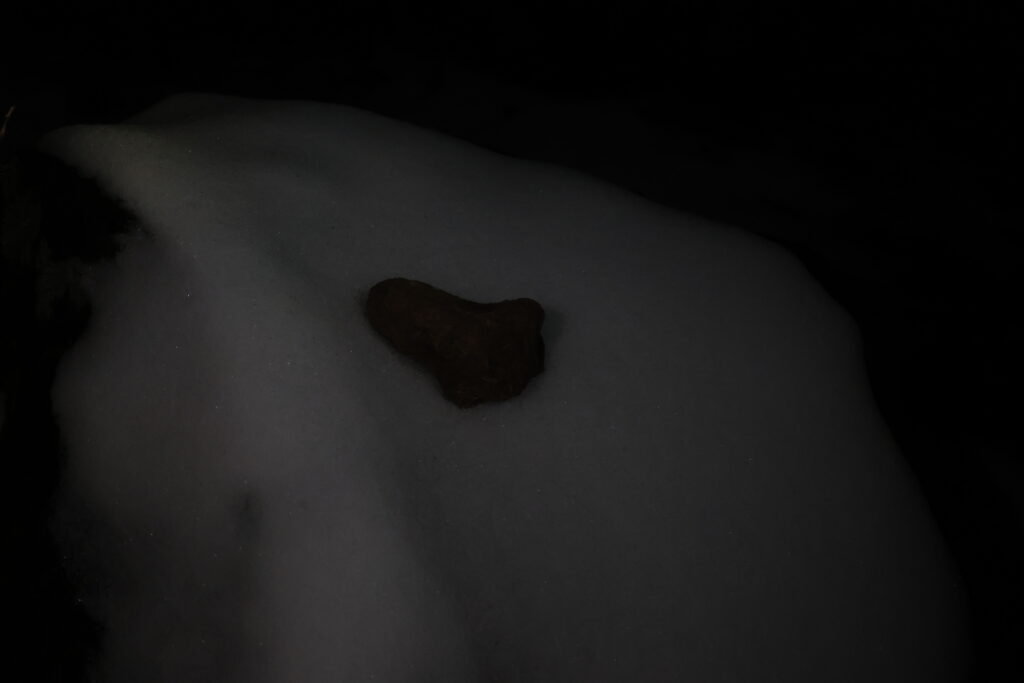
photo: 吉川永祐 Eisuke Kikkawa
ー
岸桃子は石川県金沢市にある戸室山の石を拾い、約19kmの道のりを歩いて海を見せに行った。帰りは電車とバスを乗り継いで、元の場所に石を戻した。
計12時間のパフォーマンスは、途中トラブルで断絶したものの、ほぼ全てインスタライブで中継した。
ー
「山の石に海を見せる」岸桃子
山の石を海まで運んだ。
身体を介して、海と山をつなげる行為だと思った。
地図に起こせるくらい大きなドローイング。
なぜやろうと思ったのか、理由はさっぱりわからない。
理由はなんでもよかったのかもしれない。
ただ普段から、
生きているものも、生きていないものも、
みんな形を変えていくその流れみたいなものに、
どこまでも従っていくようで、抗っているようでありたい、
みたいなことを考えていたので、
その辺りのことが、形になった行為なのかもしれない。
川になり変われるはずのない人間が、
川のふりをして山から海へ石を運ぶ。
そこに流れる時間と空間を、
例えおかしくても自然のこととして
受け止めて、受け流していく。
人生はやり過ごすためのものだとしても、
それでも腕や足のきしみや体温のある自分の身体を、
周りを取り巻くものや、人や、社会を、
まなざしていたい。
ー
「山の石に海を見せる」岸桃子
日時:2024年12月9日(月)9:00〜
会場:Curry Rice Gallery(インスタライブ @momoko_kishi)
ー
岸桃子 Momoko Kishi
彫刻家、パフォーマー、歌人。触れる・歩く・呼吸する・汗をかくといったごく身近な行為や体感をたよりに、労働、血縁、美術史などの観点から身体の社会的な位置づけ・意味づけを問う作品を制作する。
ー
レビュー『できるだけふるいまぶたをあけてみる そこには海があるはずなんだ ―― 岸桃子さん《山の石に海を見せる》に寄せて』平岡希望
掃除をして、洗濯物を干して、身支度を整えPCを開いたのが9時過ぎのことで、インスタライブの縦長の画面には “あばた顔” の石が大写しになっていた。岸桃子さんは、どうやら胸のあたりにスマホを固定しているようだ、握りこぶし2つ分くらいの石を手のひらに載せた彼女が、ザッ、ザッ、ザッ…とかすかに足音を立てながら下りる石段には、雪化粧が薄く施されている。
Google Mapを開き、戸室山、内灘海岸と入力すれば金沢市内の地図が表示され、その上に川のごとく横たわる最短ルートは19kmだが、映像の端に覗く朱色の手すり、そして長いその石段はおそらく医王山寺から続くものだ。400段を超えるという階段は登山口らしく、それを加味すればおよそ21〜22km、もちろん概算に過ぎないが、岸さんは山で拾った石を、歩いて海まで連れていく。
その間にも、デスクトップ左上に開いたウインドウでは岸さんが歩き続けていて、いつの間にか石段は真っ白な下り坂に変わっている。そしてたしかそのあたりだったか、雪道の端には水道があって、短いホースの付いた蛇口から、青いタライへと注ぐ水で彼女は土の付いた手を洗ったが、私はそれを注視し続けていたわけでもなく、締切間近の書き物をしながら目の端で見ていた。配信はいつの間にか途切れ、またいつの間にか再開した時にはすでに市内で、岸さんはコンビニで休憩している。
それがお昼時のことだったので私も昼食をとり、14時過ぎまで書き物を進めてから家を出たが、ちょうどその頃には、あとしばらく歩けば海、というところまで岸さんは迫っていた。あの後きっと到着し、石に海を見せ、今頃は帰路についているのだろう…と出先で想像したように、金沢で、半日以上かけて行われる一連のパフォーマンスを最初から最後まで見届けることは、物理的にも、時間的にもまずできない。彼女のパフォーマンスをひととき覗いた視聴者は、また各自の生活へと引き返すことになるが、「岸さんは今も石を持って歩いているはずだ」という “持続” の感覚は、何か他のことをしている間にも薄く続いていて、2001年からブキャルディ廃教会(ハルバーシュタット、ドイツ)で演奏され始めたジョン・ケージの『オルガン²/ASLSP』は、演奏終了予定の2640年まで、時に数年の休符を挟みつつも鳴り続けている。しかし、たとえそのことを知っていたとしても、数年〜十数年のスパンで進行するそれにただ耳を澄ますだけでは持続音に過ぎない。音楽として認識するには、楽譜を見て全体像を把握したり、あるいはタイトルであり指示である『ASLSP (As Slow as Possible) 』 の下、数分~数十時間に収められた他の演奏を聞いたりすることが必要で、岸さんは、
「山の石に海を見せにいく。長い年月をかけて川のやっている仕事を試しに人間がやってみる。当然川と同じ仕事はできないので、石にとっては理不尽な日帰り旅行になるだろう。」
と語っているが、このパフォーマンスもまた人間には知覚しきれない川と石の営為を “早回し” することで、人のスケールへ落とし込んでいく試みだった(逆に言えば、ハルバーシュタットにおける『ASLSP』演奏は、人の作った物がいかに人間の知覚を超えうるか、という実験なのかもしれない)。
そうした時間的な要素は Curry Rice Gallery にも通じて、「ここ」という特定の空間を持たない “ここ” ではこれまでも、例えばポストカードがDM=作品=個展会場として配布されたり(サム・ライトさん)、Google Document というツールがパフォーマンス~公開制作~アーカイブの場に仕立て上げられたりしてきた(楡木真紀さん)。
川や石の持つ時間を、人間の認識的・生物的な時間へ落とし込んだ岸さんのパフォーマンスは、Curry Rice Gallery によって社会生活的な時間へとねじ込まれて、視聴する私たちのPCやスマホ画面では、波打ち際のように時と時とが溶け合っていたのかもしれない。
「われわれの内部の持続とは何か。数とは類似しない質的多様性である。有機的展開ではあるが、増大していく量ではない。純粋な異質性であるが、その只中には、互いに区別された複数の質が存在しているのではない。要するに、内的持続の諸瞬間は互いに外在的ではないのである。」(アンリ・ベルクソン 著,合田正人,平井靖史 訳『意識に直接与えられたものについての試論——時間と自由』ちくま学芸文庫,p.249)
という一節に、私は理解というよりもむしろ、
「かつて、この話が焚火のまわりで、あるいは雨の日の小屋の中で、蜒々と語られた時、この話はもっと錯綜し、混乱し、語り手は途中でたびたび言いよどんだことだろう。筋を離れ、聞き手に助けられ、またとまどい、新しい部分を付けたし、聞いている子供の名前をこっそり物語にすべりこませ、大団円までの遠い道をのんびりと辿りつづけた。」(池澤夏樹『夏の朝の成層圈』中公文庫,p.159)
と描写されるような焚火のまわり、あるいは雨の日の小屋の中での語りじみた “熱っぽさ” を感じていて、似たようなところが Curry Rice Gallery と《山の石に海を見せる》にもある。そして、帰宅して再びPCを覗けば岸さんはまだ歩いている。予定よりも遅くなったようで、雪の日は夜でも薄明るかったりするが、街灯もない、画面越しの宵闇は雪の白さの分だけ暗い。「熊も出るかもしれないので…」と、岸さんは石を元の場所へ返すのを断念し、雪をかぶった岩の上に置き、残されたそれは、今も人知を超えた速度で海へ向かい続けているのかもしれない。
注) タイトルは、笹井宏之『えーえんとくちから』(ちくま文庫,p.30)による。
ー
平岡希望 Hiraoka Nozomu
1990年、東京都生まれ。2013年、学習院大学文学部心理学科卒業。同大学大学院を中途退学した2015年頃から美術鑑賞に目覚め、2024年5月より、ひと月に見た展示・舞台・イベントなどを日記・私小説風に書いた『平岡手帖』を毎月刊行中。それと同時に、東京都板橋区の劇場「サブテレニアン」(2023年12月~)、および「アート55(アートゴーゴー)―町田で55人のアーティストを紹介するプロジェクトー」(2024年11月~)に不定期でレビューを寄稿している。過去には、「蜘蛛と箒SNSレビュープロジェクト」(2023年5月~2024年5月)、「Durational Performance Project Tokyo」(2024年1月~8月)に参加し、掲載書籍としては、中島りか『私的なまま、現れる』、阿目虎南・腰山大雅『Glowing Ember』、南壽イサム『花粉の季節』(全て2024年刊行)などがある。
ー
Momoko Kishi picked up a rock from Mt. Tomuro in Kanazawa, Ishikawa Prefecture, and walked about 19km to see the ocean. On the way back, she took a train and a bus to return the rock to its original location.
Although the 12-hour performance was interrupted by a problem, almost the entire performance was broadcast on Instagram Live.
ー
"Show the sea to the rocks on the mountain" by Momoko Kishi
I carried rocks from the mountain to the sea.
I thought it was an act of connecting the sea and the mountains through my body.
A drawing so big that it could be drawn on a map.
I have no idea why I wanted to do it.
It could have been any reason.
I just thought about how I wanted to appear to follow and resist the flow of all living and non-living things, which changes shape, so perhaps this act was a manifestation of that idea.
Humans who cannot become rivers pretend to be rivers and carry rocks from the mountain to the sea.
I accept the time and space that flows there as a natural thing, even if it is strange, and let it go.
Even if life is something to get through,
I still want to gaze at my body, with its creaking arms and legs and warmth,
the things, people, and society that surround me.
ー
"Show the sea to the rocks of the mountains" by Momoko Kishi
Date and time: Monday, December 9, 2024, 9:00AM -
Venue: Curry Rice Gallery (Instagram Live @momoko_kishi)
ー
Momoko Kishi
Sculptor, performer, and poet. Using very familiar actions and physical sensations such as touching, walking, breathing, and sweating, she creates works that question the social position and meaning of the body from the perspectives of labor, blood ties, art history, and more.
ー
Review: "Open your eyes as long as you can - there must be an ocean there - On Momoko Kishi's "Show the sea to the rock of the mountain" by Nozomu Hiraoka
After cleaning, hanging out the laundry, getting ready, and opening my PC, it was just after 9 o'clock, and a stone with a "pockmarked face" was displayed in full view on the vertical screen of the Instagram Live. Kishi Momoko appears to have her smartphone fastened to her chest, and with a stone the size of two fists in her palm, she makes a faint sound as she descends the stone steps, which are lightly dusted with snow.
Open Google Maps and enter Tomuroyama, Uchinada Coast, and a map of Kanazawa city will appear, with the shortest route lying on top of it like a river being 19km, but a vermilion handrail can be seen peeking out from the edge of the image, and the long stone steps are probably continuing from Iōsan-ji Temple. The staircase, which is over 400 steps, appears to be the trailhead, so taking this into account makes it about 21-22km, of course only a rough estimate, as Kishi walks away with the stones she picked up in the mountains to the sea.
All the while, in the window open in the top left of the desktop, Kishi continues walking, and before you know it, the stone steps have turned into a pure white downward slope. And it was around that time that she came across a water tap at the edge of the snowy road, and she washed her dirt-stained hands with water from a tap attached to a short hose that poured into a blue basin, but I didn't keep my eyes on her, just watched from the corner of my eye as I was writing, my deadline was fast approaching. The stream cut off at some point, and when it resumed again, we were already in the city, and Kishi was taking a break at a convenience store.
It was lunchtime, so I had lunch too, and continued writing until just after 2 p.m. before I left the house, and just by that time Kishi was close to the sea, just a short walk away. He must have arrived after that, shown the sea to the rocks, and was probably on his way home by now…I imagined while I was out, but it was simply not possible, both physically and in terms of time, to watch a series of performances that took more than half a day in Kanazawa from start to finish. After peeking into her performance for a moment, the audience returns to their own lives, but the sense of “continuity” that “Kishi-san must still be walking around with the stone” continues faintly even while they are doing other things, and John Cage’s “Organ²/ASLSP,” which began to be performed at the abandoned Buchardi Church (Halberstadt, Germany) in 2001, will continue to ring, occasionally with rests of several years, until the performance is scheduled to end in 2640. However, even if you know that, if you simply listen carefully to the sound that progresses over a span of several years to a dozen years, it is nothing more than a continuous sound. To recognize it as music, one must look at the score and get the whole picture, or listen to other performances that last from a few minutes to a few dozen hours under the title and direction of "ASLSP (As Slow as Possible)." Kishi said, "I'm going to show the ocean to the rocks on the mountain. I'm going to try to do the work that the river has been doing for many years. Of course, I can't do the same work as the river, so it's going to be an unreasonable day trip for the rocks." This performance was also an attempt to reduce the activities of the river and rocks, which humans cannot fully perceive, to a human scale by "speeding up" them (conversely, the performance of "ASLSP" in Halberstadt may be an experiment in how much man-made things can surpass human perception). This element of time is also present at Curry Rice Gallery, where in this "here" that does not have a specific space, postcards have been distributed as direct mail, works, and exhibition spaces (Sam Wright), and a tool called Google Documents has been turned into a space for performance, public production, and archiving (Maki Niregi).
Kishi's performance, which reduces the time of rivers and stones to the cognitive and biological time of humans, was twisted into the time of social life by Curry Rice Gallery, and on our PC and smartphone screens watching, time and time may have blended together like the shoreline.
"What is our internal duration? It is a qualitative diversity that is not similar to numbers. It is an organic development, but not an increasing quantity. It is pure heterogeneity, but in the midst of it, there are not multiple qualities that are distinct from one another. In short, the moments of internal duration are not external to one another." (Henri Bergson, Masato Goda, Yasushi Hirai) (translation: "An Essay on What is Directly Given to Consciousness - Time and Freedom" Chikuma Gakugei Bunko, p.249)
Rather than understanding, I felt the "heat" of a story told around a campfire or in a hut on a rainy day described as "when this story was once told around a campfire or in a hut on a rainy day, it would have been more complicated and confusing, and the narrator would have faltered many times along the way. He would stray from the plot, be helped by his listeners, get confused again, add new parts, sneakily slip the names of children listening into the story, and continue to leisurely follow the long road to the climax." (Ikezawa Natsuki, "Stratosphere of a Summer Morning" Chuko Bunko, p.159)
There are similar parts in Curry Rice Gallery and "Show the Sea to the Mountain Stones". And when I got home and checked my PC again, Kishi-san was still walking. It seems to have been later than planned, and although it is sometimes dimly lit even at night on snowy days, there are no street lights, and the darkness seen through the screen is darker due to the whiteness of the snow. "Because bears might come out…", said Kishi, giving up on returning the stone to its original place and placing it on a snow-covered rock, where it may still be heading toward the sea at a speed beyond human comprehension.
Note: The title is from Hiroyuki Sasai's "E-entokuchikara" (Chikuma Bunko, p.30).
ー
Hiraoka Nozomu
Born in Tokyo in 1990. Graduated from the Department of Psychology, Faculty of Letters, Gakushuin University in 2013. After dropping out of the university's graduate school in 2015, he became interested in art appreciation, and since May 2024, he has been publishing "Hiraoka Techo" every month, a diary/personal novel-style journal of exhibitions, plays, and events he has seen in a month. At the same time, he will be contributing reviews on an irregular basis to the theater "Subterranean" in Itabashi Ward, Tokyo (from December 2023) and "Art 55 (Art Go Go) - A project introducing 55 artists in Machida" (from November 2024). In the past, he has participated in the "Spider and Broom SNS Review Project" (May 2023-May 2024) and "Durational Performance Project Tokyo" (January-August 2024), and his published books include Nakajima Rika's "Private Appearance," Amane Tonan and Koshiyama Taiga's "Glowing Ember," and Minami Hisashi's "Pollen Season" (all published in 2024).
